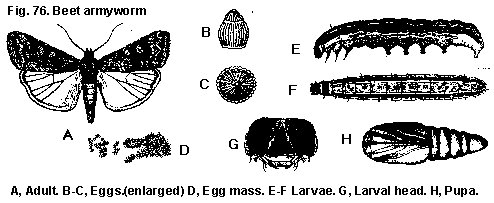DESCRIPTION Adult- The beet armyworm adult is a grayish brown moth with a pale circular spot near the middle of the forewing. The wingspan is 25 to 30 mm. The hind wings are whitish with dark edges. Larva- First and second instars are pale green with dark heads. Older caterpillars are green to almost black with stripes along each side. Beet armyworms always have a black spot on the side above the second pair of legs (counting from the head). Pupa- At first the beet armyworm pupa is light brown, but it soon darkens.
Fig. 76: Beet Armyworm Spodoptera
exigua (Hubner), Noctuidae, LEPIDOPTERA BIOLOGY Distribution- The beet armyworm originated in southern Asia and has since spread throughout most temperate and tropic countries. Host Plants- The beet armyworm has an extremely wide host range including numerous ornamental crops such as roses and geraniums. Chrysanthemums, carnations, and Gypsophila are especially preferred. Damage- Beet armyworms web foliage together and feed within this shelter. They also bore into flower buds. Older larvae feed extensively on flowers, buds, and foliage. Life History- The beet armyworm has several generations per year. Flight activity is greatest in July and August. Eggs are laid in masses of 15 to 150 mostly on the undersides of leaves and mostly within 10 cm of the soil surface. Females may cover the eggs with a mat of scales that protects them from parasites and insecticides. Females prefer younger plants to older plants. Two to 9 days later the eggs hatch. First and second instar beet armyworms feed in groups, especially in the growing tips where they web several leaves together. Older larvae do not restrict feeding to young leaves. The third and fourth instars last 1 to 3 days. The fifth instar feed for 2 to 6 days. Beet armyworms are cannibalistic, particularly when feeding on plants with low nitrogen levels. Moths that develop from cannibalistic caterpillars lay more eggs than moths that developed from caterpillars that fed only on plant material. Mature beet armyworms tunnel into the soil 2.5 cm and form a cell in which they pupate. The pupal stage lasts 4 to 11 days. The moths are nocturnal and mating and egg laying occur at night. Females deposit up to 600 eggs during their 7- or 8-day life. Moths may live up to 30 days. CONTROL Cotesia marginiventris (Cresson) is a common parasite of the beet armyworm. Meteorus laphygmae Viereck, Pristomerus spinator (Fabricius), Campoletis flavicincta (Ashmead), and Chelonus insularis Cresson also parasitize the immature stages of the beet armyworm. A polyhedrosis virus sometimes causes epizootics in beet armyworm populations that causes virtually 100 percent mortality in some fields. The beet armyworm is difficult to control with chemicals because the young larvae web leaves together and feed under the webbing that protects them from insecticides. Older larvae are more tolerant of pesticides. In addition, some beet armyworm populations have acquired resistance to methomyl and perhaps other pesticides. Pheromone traps can help monitor for moth flight activity. All Bacillus thuringiensis strains are not necessarily acutely toxic to beet armyworms, but some strains do cause significant mortality and stunt the development of surviving caterpillars. The use of bacterial pesticides may help delay the acquisition of resistance to pesticides by the beet armyworm. For specific chemical control recommendations, consult the current Cooperative Extension Service publications on ornamental plant pest management. |
